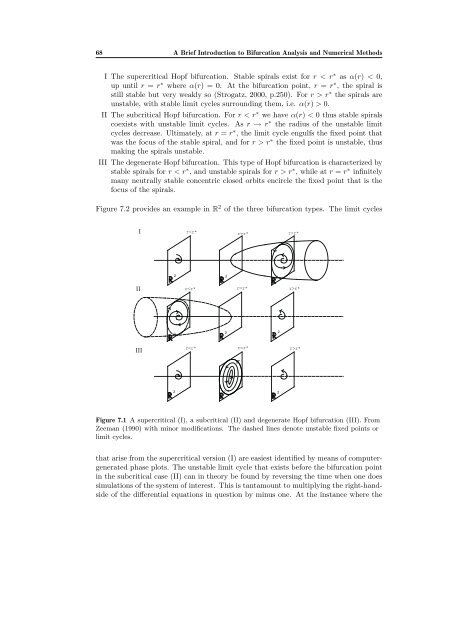nr. 477 - 2011 - Institut for Natur, Systemer og Modeller (NSM)
nr. 477 - 2011 - Institut for Natur, Systemer og Modeller (NSM)
nr. 477 - 2011 - Institut for Natur, Systemer og Modeller (NSM)
You also want an ePaper? Increase the reach of your titles
YUMPU automatically turns print PDFs into web optimized ePapers that Google loves.
68 A Brief Introduction to Bifurcation Analysis and Numerical Methods<br />
I The supercritical Hopf bifurcation. Stable spirals exist <strong>for</strong> r < r ∗ as α(r) < 0,<br />
up until r = r ∗ where α(r) = 0. At the bifurcation point, r = r ∗ , the spiral is<br />
still stable but very weakly so (Str<strong>og</strong>atz, 2000, p.250). For r > r ∗ the spirals are<br />
unstable, with stable limit cycles surrounding them, i.e. α(r) > 0.<br />
II The subcritical Hopf bifurcation. For r < r ∗ we have α(r) < 0 thus stable spirals<br />
coexists with unstable limit cycles. As r → r ∗ the radius of the unstable limit<br />
cycles decrease. Ultimately, at r = r ∗ , the limit cycle engulfs the fixed point that<br />
was the focus of the stable spiral, and <strong>for</strong> r > r ∗ the fixed point is unstable, thus<br />
making the spirals unstable.<br />
III The degenerate Hopf bifurcation. This type of Hopf bifurcation is characterized by<br />
stable spirals <strong>for</strong> r < r ∗ , and unstable spirals <strong>for</strong> r > r ∗ , while at r = r ∗ infinitely<br />
many neutrally stable concentric closed orbits encircle the fixed point that is the<br />
focus of the spirals.<br />
Figure 7.2 provides an example in R 2 of the three bifurcation types. The limit cycles<br />
I<br />
II<br />
III<br />
2<br />
rr*<br />
2 2 2<br />
rr*<br />
2 2<br />
2<br />
rr*<br />
Figure 7.1 A supercritical (I), a subcritical (II) and degenerate Hopf bifurcation (III). From<br />
Zeeman (1990) with minor modifications. The dashed lines denote unstable fixed points or<br />
limit cycles.<br />
that arise from the supercritical version (I) are easiest identified by means of computergenerated<br />
phase plots. The unstable limit cycle that exists be<strong>for</strong>e the bifurcation point<br />
in the subcritical case (II) can in theory be found by reversing the time when one does<br />
simulations of the system of interest. This is tantamount to multiplying the right-handside<br />
of the differential equations in question by minus one. At the instance where the<br />
2<br />
2
















